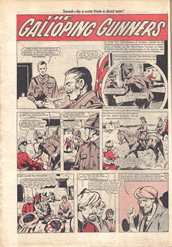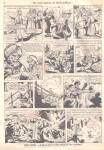


The above map shows India's North West Frontier in 1919. Map from the book by Trench, Charles The Frontier Scouts.- Oxford University Press, 1986.-
See The Victor issues 382 to 398; (15th June 1968 to 05th October 1968); S1968.
Writer:- The Victor editorial team. Artist:- Vicente Ibáñez Sanchis?
Main cast:- Gunner (later Lance-Bombardier, then Bombardier; then Sergeant and finally Sergeant-Major) Tom Holliday; Gunner Mickey Finn; Major Dunsany.
Time period:- 1915 through to 1934, Kohat cantonment on India's North-West Frontier.
Holliday serves with Sargon Section of 524 Field Battery of Artillery, known as the Galloping Gunners. The second section is known as Tiflis Section. The Field Battery use 18 pounder artillery guns. (Further information about these guns appears further on down this page).
This centre 'colour'* (see below), series tells of the adventures of the young, inexperienced Gunner Tom Holliday from 1915, following the character's career through to 1934. By the time the series finishes Holliday is a Sergeant-Major. Holliday and his friend Gunner Mickey Finn are sometimes at the centre of the story, whilst in other episodes the action revolves around other characters introduced for that story, with Holliday and Finn appearing as and when necessary. This style of story telling also continued in Holliday's second series The War of the Second Best Guns, set in the Western Desert, Africa during World War Two. This series will be reviewed later this month.
At the beginning of the series, Holliday resents being posted to India, which he regards as being away from the real fighting on the Western Front. So much so that he resolves to desert and head for France. Holliday leaves the camp at night and immediately runs into trouble with some hostile natives. Will he betray his colleagues in the fort to save his own life? After this adventure, Holliday discovers that life in North-West India is just as dangerous as fighting on the Western Front.
Other stories include Captain Williams an intelligence officer on one of his missions (issue 383, story below); Ghazan Khan a panthan who is a range attendant at the British fort, settling a blood feud (issue 384); Lieutenant Luke Dunsany who likes war just a little too much for his men's liking.
Other characters to appear briefly in the series include -
Major Dunsany officer commanding 524 Field Battery. An experienced, trusted, shrewd, world weary officer, who has a full understanding of his men, the local politics and the make up of the area's social society. He knows which natives to trust and when. An officer trusted by his men and the locals. Suffers a personal tragedy when his brother Lieutenant Luke Dunsany, who had served on the Western Front in France, is killed in action on the North-West Frontier. The irony being that Major Dunsany had arranged for his brother to be transferred to India, so that he wouldn't be killed in France. Major Dunsany appeared throughout the series.
Gunner Mickey Finn - Holliday's friend. Wounded by a faulty charge exploding the gun it was fired from. Suffered a head injury from a bit of breech-ring. He survived the injury and at some point between 1929 and 1934 left the army to become a tea plantation owner in Assam. He invites Holliday to join him as a full partner. The end of the series sees Holliday mulling over the idea. But as Holliday also appears in The War of the Second Best Guns, set during World War Two, maybe he took up the offer for a few years, before re-joining the army.
Note - a 'mickey finn' is a surreptitiously drugged or doctored drink. The origin possibly being named after a notorious Chicago saloon-keeper, circa 1896 to 1906. From the www.askoxford.com site. Maybe Mickey's parents had a strange sense of humour!
A short history and facts about the 18 pounder gun
Sources
Wikipedia,
The following adventures of Tom Holliday are from issues 383, 389, 394, 397.
* The centre page stories in the weekly comic consisted of just one colour - red. Although different shades of red were used. The Victor Annuals would see stories using other colours. But again these 'colour' stories consisted of just one colour..
 |
 |
 |
 |
 |
 |
 |
 |
 |
 |
 |
 |
 |